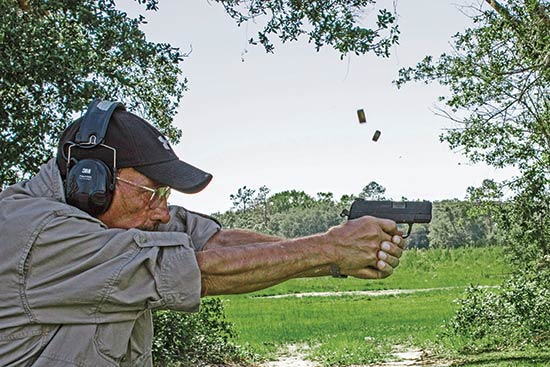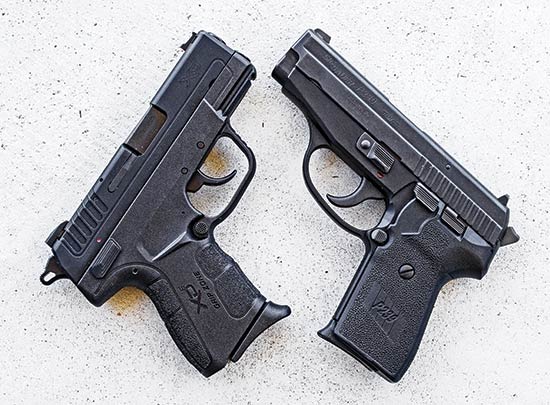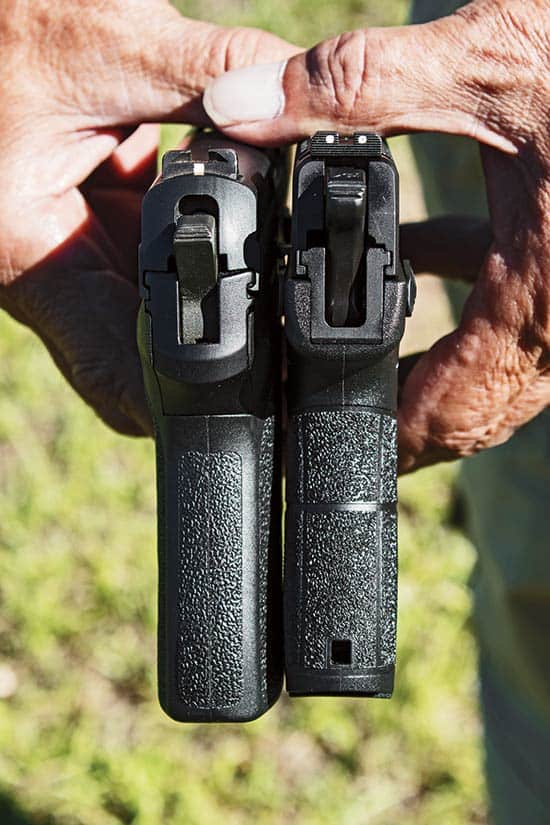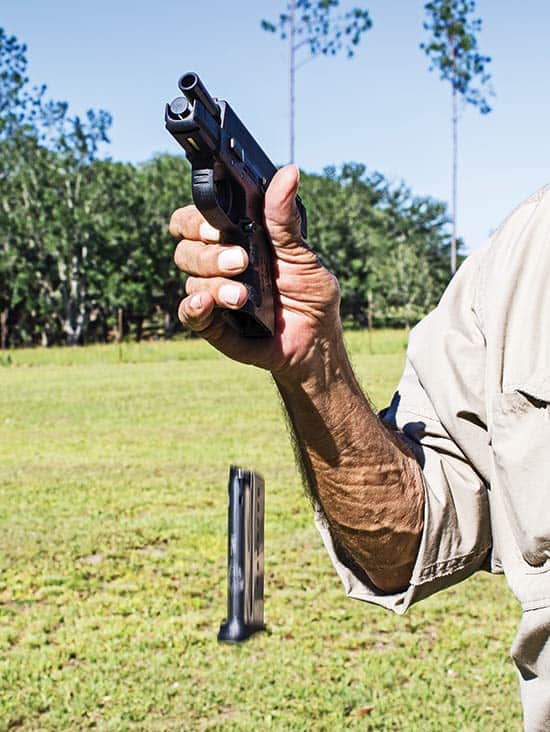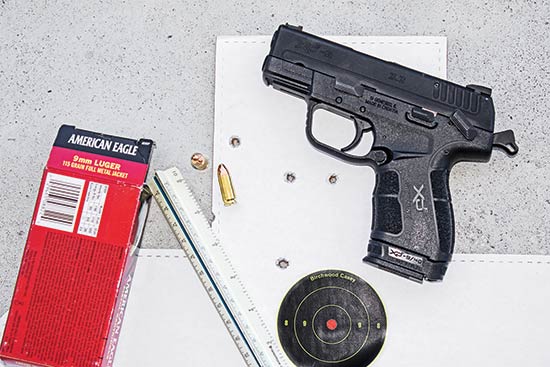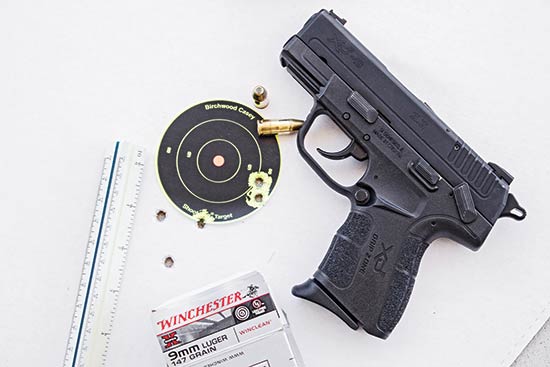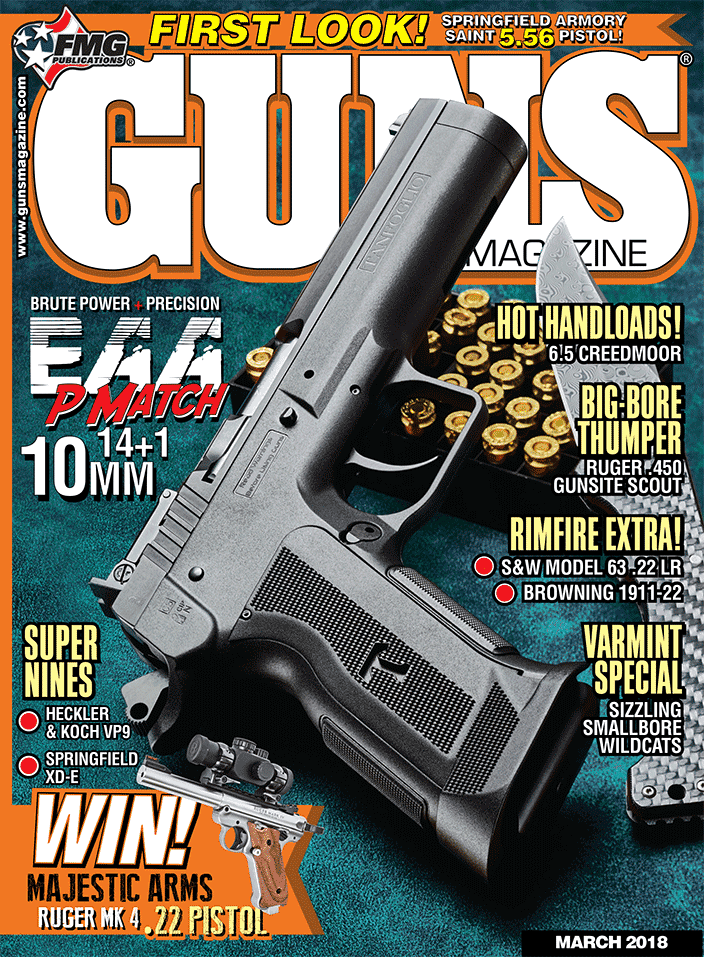Hammer Time!
For CCW Springfield’s XD-E Excels, Offering Cocked-And-LockedCarry,
Super-Slim Size And A Stand-Off Feature
One of the Big Things at the 2017 NRA Show in Atlanta was Springfield Armory’s new polymer-frame XD-E, the company’s first double-action semi-automatic pistol. The introduction prompted many to ask “Why ‘retro’? Doesn’t Springfield Armory know it’s a striker-fired world now? Heck, they helped make it so with all their XD guns!”
Springfield’s theme for the new gun was “The Hammer Reinvented.” Anyone who thinks traditional double-action pistols are obsolete won’t understand the appeal. The sales success of SIG’s Legion pistols (mostly TDA) Wilson Combat’s Berettas (all TDA), and Beretta’s own recent line inspired by Ernest Langdon all show the TDA is far from dead.
Tradition Revisited
Many people feel the long, heavy pull for the first shot is a hedge against unintentional discharge under stress, and under some circumstances this can certainly be true. Another factor is the popularity of Appendix Carry Inside the Waistband, which can leave the muzzle of a loaded gun pointed at your private parts and femoral artery, which could be very bad if some foreign object (most likely, but not limited to, an over-eager trigger finger) trips the trigger. With the thumb holding the hammer down on a double action or back on a single-action pistol as the gun goes into its ACIWB resting place, there’s one more safety net in place to prevent the this type of mishap.
The XD-E is selective double action, meaning it can be carried hammer down waiting for a long, heavy pull for the first shot and will self-cock to single action for subsequent shots (until decocked), or carried cocked-and-locked for a single-action pull from the start. This gives you a choice of three carry modes: Double-action on-safe, double-action off-safe, or cocked and on-safe. The thumb safety is ambidextrous and also serves as a decocking lever, much like a Variant One in the Heckler & Koch TDA autos. Lever up is safe, lever down parallel to the barrel is off-safe, and all the way down will decock the gun (the lever snaps back up to the “fire” position as soon as the hammer is safely down). The slide can be manipulated and the chamber cleared with the lever in the on-safe position.
XD-E Features
The pistol features a dual spring recoil system, full-length guide rod and what the company refers to as a “low effort” slide for easy racking. The XD-E is what I call a “slim-nine,” a compact 9mm with a very flat profile and single-stack magazine. It comes steel 8-round mag with a little finger extension on the floorplate as well as a longer 9-round magazine.
Particularly useful is the fact its prognathous recoil-spring guide rod gives the XD-E standoff capability, which means if the muzzle is pressed hard against a firm surface when the trigger is pulled, it won’t go out of battery and fail to fire, as most autos are wont to do in such situations. In a belly-to-belly lethal force situation, this can be the difference between life and death. Some other Springfield handguns— notably the XD Service models with 4-inch barrels and the XD(s) Subcompact—share this feature. Why Springfield doesn’t advertise this feature far and wide—and loud—I’ve never understood.
(During my subsequent range testing, I tested the gun’s stand-off capability by using an old hardcover book as the contact surface. The shot went off just as expected, the 115-grain FMJ burying itself in the ground below the book).
In overall size and shape, the XD-E has a footprint almost identical to another popular TDA carry gun, the SIG P239. The XD-E is, however, visibly thinner and slightly lighter—and significantly less expensive. A P239 starts at $957, the XD-E at $519. Though spec’d for the same 25 ounces (empty) as a P239, our test XD-E tipped my scales at only 22.5.
Another feature is an ambidextrous magazine release. Yes, a button on each side. Handy for southpaws, I also found it faster to work right handed with my trigger finger rather than with my thumb.
Range Performance
My standard protocol involves a Caldwell Matrix rest, a concrete bench, 25-yard targets, and loads in the three most common bullet weights for the caliber. Groups are measured center-to-center between the two farthest-apart bullet holes (to the nearest 0.05-inch). The first measurement for the whole 5 shots gives me a good idea of what the gun can do with maximum hand-held stability. The second measurement is of the best 3 of those hits. Decades have proven to my satisfaction this pretty much duplicates what the same gun/ammo combo will do from a machine rest, and is much more convenient for readers to duplicate.
My chosen 115-grain load was some of the most accurate economy-priced training “ball” available—American Eagle FMJ. It turned out not to be the XD-E’s favorite—3.55 inches was the best 5-shot measurement though the best 3 were in a more reassuring 2.85.
For a 124-grain load I chose the recently introduced SIG V-Crown JHP, which runs at standard pressure and has earned my respect for its good accuracy from other pistols. In the new Springfield, it ran right at 3.10 inches for all 5, with the best 3 in 1.80.
Since you can’t really test a 9mm in America without trying a 147-grain subsonic, I also used Winchester WinClean truncated cone training ammo. This grouped tightest in both measurements—2.85 inches for all 5, and a very pleasing 1.20 for best 3. My XD-E seemed just about built for the 147-grain 9mm, and in more ways than one.
Holding center on a 2.90-inch Shoot-N-C aiming dot, I had gotten hits averaging about 3 inches above point of aim at 25 yards with the 115- grain load. Adjusting with a 6 o’clock hold using the 124-grain load pulled the cluster tighter toward the black bull, with average point of impact less than 2 inches high. However, a 6 o’clock hold with the 147-grain WinClean clustered those bullets at… 6 o’clock. In other words, dead-on point-of-aim/point-of-impact coordination!
Frankly, the 147 shooting lower than lighter bullets surprised me, because usually it’s just the opposite. In most 9mm’s I hit higher with the subsonic 147’s than with lighter, faster loads. I can’t explain it, so I’ll just report it.
Operational Notes
The ambidextrous safety/decock lever wasn’t hard for me to use in decock mode, though one of our shooters had a little bit of trouble with it. The lever moved smoothly yet positively off-safe, but most of us needed to shift our hand slightly to get enough leverage to push it back up to the on-safe position. Weaned on the 1911, I found the safety lever just far enough back from its usual place that I wound up hitting it with the skin just below the median joint of my thumb. Not impossible, but, unfamiliar.
The XD-E’s DA trigger reach was surprisingly long and particularly difficult for the short-fingered female of our test group. The toe (lower tip) of the trigger was pointy, with little clearance above the inside bottom portion of the triggerguard. This caused the flesh of the finger to get pinched there when firing double action. Not enough to stall the trigger stroke, but annoying as hell. That did not happen to all the test shooters though.
The thinness of the XD-E (a bare inch at its widest point) coupled with the flatness of the grip makes it extremely comfortable to carry inside the waistband. However, this configuration leaves little of the grip contacting the hollow of your palm, a feel neither comfortable nor reassuring. Fortunately, however, in actual live-fire, the XD-E never shifted in my hand, nor in the hands of our other shooters.
Measured from the natural finger position at the center of the trigger, the long DA pull averaged 11.09 pounds, relatively heavy but smooth and consistent—with no palpable stacking. In SA mode the pull averaged 6.31 pounds, measured on a Lyman digital scale. The SA pull, incidentally, is more of a roll than the proverbial “glass-rod break” target shooters prefer, but proved quite manageable. Trigger reset required a fairly long forward return—a safety feature for some, an annoyance for others.
I like to shoot a carry gun in something like an IDPA match—or at least a qualification course—to see how the thing handles when I’m under some element of pressure. For scheduling reasons it had to be the latter. My regular qual course starts off at 4 yards, with 6 shots in 8 seconds. That comes from the NRA Police Service Pistol course. They do it at 3 yards, strong hand only. We do it a yard farther back, once with each hand. Because of the DA trigger finger pinch I experienced, I ran the XD-E cocked and locked.
Using my weak left hand only, things started off fine, with the gun canted about 15 degrees in the McMillan/Chapman Tilt to bring the red fiber optic front sight into line with my dominant right eye. The mild recoil and controllable trigger allowed my less-dexterous hand to shoot a pleasingly tight group. Ditto when I subsequently shot dominant hand only. Moving back to 7 yards and shooting 2-handed, it was easy to put 6—followed by a reloaded 6 more—in the same place. Reloads went smoothly and uneventfully. Recoil was predictably mild and sight recovery between shots quick, despite the XD-E’s relatively high bore axis.
Moving back to 10 yards for low cover positions, though, I forgot to allow for the XD-E shooting high with the 115-grain American Eagle, and the hits started going north. Farther back, I overcompensated with too deep a 6 o’clock hold and a few shots went low. That was enough to keep everything in the center 5-point rectangle of the IPSC silhouette, and though it wasn’t the best group I had ever shot over that course, it was still a 100 percent score. With a little “slim-nine,” I can’t complain.
Carrying The XD-E
If you’re gonna test a carry gun, ya gotta, well… carry it. This presented a bit of a problem. There will be lots of holsters available for the XD-E by the time you read this, I suspect, but the curse of new model guns is holsters fitting them always lag behind. Springfield Armory didn’t even have their XD Gear carry stuff ready when they sent me their early production sample. By a process of elimination, I determined single-stack magazine pouches for 1911 magazines fit the XD-E’s mags close enough.
The holster was a bit more difficult. The much squarer triggerguard of the XD-E made it clear from the start it wouldn’t fit a SIG P239 holster, nor did it fit one for the great old Smith & Wesson Model 3913. Oddly enough, the best fit was a Galco skeleton scabbard for a GLOCK 21. The XD-E is a much smaller and thinner gun, but the relatively long distance between the top of the slide and the bottom of the triggerguard made it a relatively good fit in the G21 holster. I later discovered a Blackhawk CQC leather scabbard for Springfield’s striker-fired XD was also an adequate fit. For a belt I used the excellent new Moss Custom double-lined leather.
With a mag release button facing outward thanks to the ambi feature, I worried about it being bumped and accidentally releasing the magazine. I deliberately bumped the holstered pistol against a doorframe trying to make this happen but I couldn’t.
Carried cocked-and-locked beneath an untucked, open-front Columbia-style shirt, the XD-E simply disappeared. The very flat shape of the pistol all but eliminates bulge, and even with the longer 9-round magazine in place, the XD-E hid fine. I then wore it “de-cocked” in DA mode for a while to see if the burr shape of the lowered hammer would dig into my side. It didn’t. The XD-E fulfills its “concealed mission parameter” very well.
Reliability throughout our testing process was 100 percent. Fellow writer Tam Keel to date has more than 600 rounds through her test XD-E with no malfunctions, and I have close to that through mine with the same result.
Bottom line? This retro design has a lot to offer and I suspect the XD-E will appeal to a lot of modern pistol packers.
Moss Custom Leather
P.O. Box 971
Waxhaw, NC 28173
(704) 998-1778
www.mosscustomleather.com
